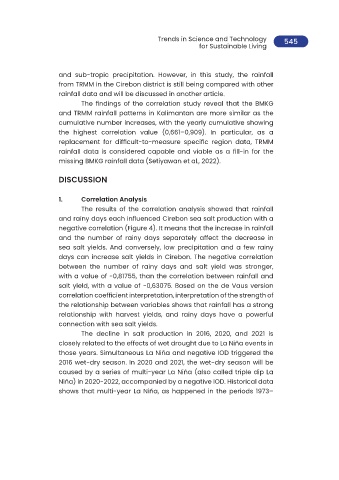Page 584 - Trends in Science and Technology fo Sustainable Living
P. 584
Trends in Science and Technology 545
for Sustainable Living
and sub-tropic precipitation. However, in this study, the rainfall
from TRMM in the Cirebon district is still being compared with other
rainfall data and will be discussed in another article.
The findings of the correlation study reveal that the BMKG
and TRMM rainfall patterns in Kalimantan are more similar as the
cumulative number increases, with the yearly cumulative showing
the highest correlation value (0,661–0,909). In particular, as a
replacement for difficult-to-measure specific region data, TRMM
rainfall data is considered capable and viable as a fill-in for the
missing BMKG rainfall data (Setiyawan et al., 2022).
DISCUSSION
1. Correlation Analysis
The results of the correlation analysis showed that rainfall
and rainy days each influenced Cirebon sea salt production with a
negative correlation (Figure 4). It means that the increase in rainfall
and the number of rainy days separately affect the decrease in
sea salt yields. And conversely, low precipitation and a few rainy
days can increase salt yields in Cirebon. The negative correlation
between the number of rainy days and salt yield was stronger,
with a value of -0,81755, than the correlation between rainfall and
salt yield, with a value of -0,63075. Based on the de Vaus version
correlation coefficient interpretation, interpretation of the strength of
the relationship between variables shows that rainfall has a strong
relationship with harvest yields, and rainy days have a powerful
connection with sea salt yields.
The decline in salt production in 2016, 2020, and 2021 is
closely related to the effects of wet drought due to La Niña events in
those years. Simultaneous La Niña and negative IOD triggered the
2016 wet-dry season. In 2020 and 2021, the wet-dry season will be
caused by a series of multi-year La Niña (also called triple dip La
Niña) in 2020-2022, accompanied by a negative IOD. Historical data
shows that multi-year La Niña, as happened in the periods 1973–

